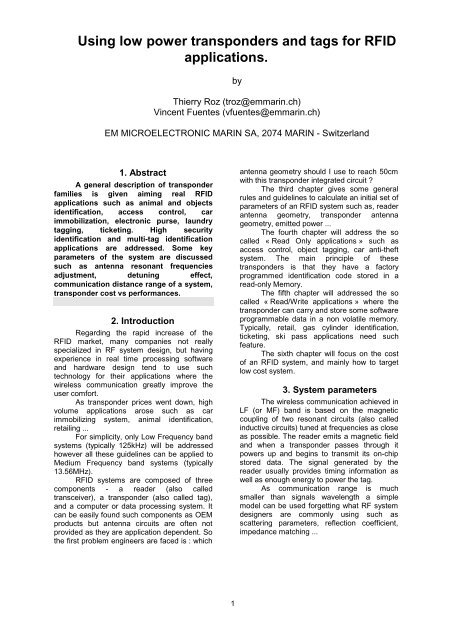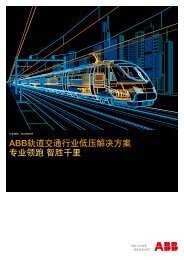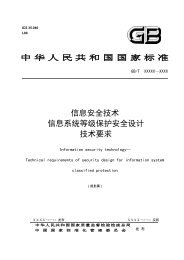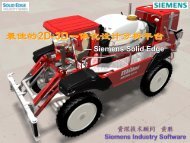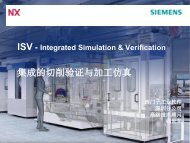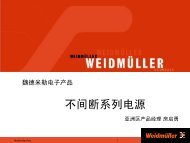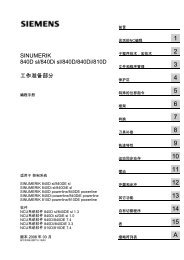Using low power transponders and tags for RFID applications.
Using low power transponders and tags for RFID applications.
Using low power transponders and tags for RFID applications.
You also want an ePaper? Increase the reach of your titles
YUMPU automatically turns print PDFs into web optimized ePapers that Google loves.
When having determined L tx <strong>and</strong> L tag , theantenna design phase can start. To completethis study, we give in (15) an empirical <strong>for</strong>mula<strong>for</strong> antenna design which gives goodagreement between calculation <strong>and</strong>measurements.2 2008 . . d . nL( m H)=3d + 9l + 10ewhere ndle= number of windings,= coil diameter (cm)= coil width (cm)= coil thickness (cm)(15)Finally, all this shows the importance tomaximize antenna Q factor on both sides,reader <strong>and</strong> transponder but there are somelimitations. The frequency b<strong>and</strong>width of thereader antenna should not be <strong>for</strong>gotten as it isa function of the Q factor, <strong>and</strong> transponderdata rate must be included in this frequencyb<strong>and</strong>width. Also, each antenna circuit has gotfrequency tuning tolerances due to componentvariations. It has to be reminded that to simplifythe previous calculation, a perfect frequencytuning between field frequency <strong>and</strong> antennasresonant circuit has been assumed. There<strong>for</strong>e,after a first set of system parameters has beencalculated using above <strong>for</strong>mulas, a seconditeration process should be done including theeffect of frequency detuning to check if thecomponents tolerances meet the overallsystem per<strong>for</strong>mance requirements.4. LF Read Only transponder<strong>applications</strong>When in 1993, a major Germaninsurance company put up pressure to eitherprotect vehicles against massively increasingtheft or else renounce to full insurancecoverage, nobody believed that <strong>RFID</strong> as a thenemerging technology would see one of it's firstmajor successes, still unbeaten in numbers byany other application today. Objection wasraised as to the reliability of potential systems,their suitability in an automotive environment<strong>and</strong> of course, the lack of st<strong>and</strong>ards in whatthen seemed to be a mystic collection ofproprietary systems, was seen to be a majorobstacle.An extremely fast but substantialdevelopment ef<strong>for</strong>t was undertaken by a few<strong>power</strong>ful automotive industry suppliers,resulting in a miniaturized "Inkey" system <strong>and</strong>it's car lock transceiver counterpart to be fittedto new cars as early as 1994 already. This firstgeneration system, still fitted to certain modelsof most major car makers, consisted of a 64 bitread-only, rod or brick type transponder,embedded in the ignition key of the vehicle <strong>and</strong>a transceiver antenna with it's electronicspackage on PCB, integrated around <strong>and</strong>behind the lock. The functionality consists of5safely cutting <strong>power</strong> supply to the starter, thefuel pump, the system ignition <strong>and</strong> othersystem elements, required <strong>for</strong> the vehicle'soperation during driving <strong>for</strong> the case, where thepresented key does not match one of the prestoredcodes. Specifications <strong>for</strong> theminiaturized <strong>transponders</strong> were very stringent,requiring maximum read distance in a metalloaded environment over industry practicethermal ranges with only a few ppm failure rateadmitted! Three mainstream systems wereadopted by the majority of the automotiveindustry <strong>and</strong> have since been fitted to millionsof new cars with great success. Immobilizerstoday in Europe are part of the normalequipment of cars <strong>and</strong> whilst still no st<strong>and</strong>ardrules neither the application nor the products,several systems have established a de factost<strong>and</strong>ard <strong>and</strong> wide public acceptance: What isgood <strong>for</strong> the automotive industry can be usedin many <strong>applications</strong> elsewhere!In parallel, a variety of retrofit systemswere developed to protect vehicles already putinto circulation. Most of these contactlesssystems rely on the same principle except thatthey use keyholders <strong>and</strong> that their transceiversare mounted inside a more convenient place inthe dashboard. Their success in the marketwas not as expected <strong>and</strong> their need is nolonger given, considering that almost allEuropean vehicles are now equipped with OEMsystems.The possibility to emulate the code withan unsophisticated reader/transponder blackbox<strong>and</strong> hence to circumvent the immobilizerwas early 1995 at the origin of a newdevelopment, aiming at increased securityfeatures. It was widely felt, that the barrier levelwas not high enough <strong>and</strong> that the target of an80% reduction of car thefts, mainly <strong>for</strong> high-endmodels, could be missed. Second generationproducts now interface with several moremotor management functions <strong>and</strong> the readwrite<strong>transponders</strong> feature encrypting in thecommunication with the lock, renderingfraudulent attempts to drive away with thevehicle almost impossible. As an example, atypical encrypted communication protocol socalled « challenge/response » is described infigure 4. Statistics of stolen cars, fitted with firstgeneration immobilizers, showed however, thatthe problem had been dramatically reduced<strong>and</strong> the objective had been met if notexceeded.One of the first <strong>RFID</strong> <strong>applications</strong> wasanimal ID <strong>and</strong> whilst this most usefulapplication never came to the importance thatit should have done, it still is the first domainwith an official st<strong>and</strong>ard. ISO 11784/11785,released in 1996/7 indeed lay down the rules,applying to a variety of ID products such asimplants, ear marks, bolus etc. <strong>and</strong> areintended <strong>for</strong> establishing a traceability,predominantly <strong>for</strong> herd animals. The st<strong>and</strong>ard
users to the same extent as are bar code<strong>and</strong>/or magnetic stripe tickets.The watch application st<strong>and</strong>s <strong>for</strong> a seriesof opportunities, where the digital interfacebetween human beings <strong>and</strong> machines greatlyfacilitates desired transaction; both in time <strong>and</strong>accuracy. The fact that <strong>RFID</strong> watches areperceived to be a necessary, even fashionableaccessory of people will add to theunderst<strong>and</strong>ing <strong>and</strong> public acceptance of thetechnique.Another important application field ofR/W transponder is the multi-tag identificationwhere sending in<strong>for</strong>mation to the tag is anabsolute requirement. For <strong>applications</strong> likelaundry automation, textile rental, inventorycontrol, it is necessary to identify <strong>and</strong> countseveral <strong>transponders</strong> present at the same timewithin a reader RF field. One of most knownprotocol is the so called Supertagä anticollisionprotocol developed in CSIR (South ofAfrica) <strong>and</strong> licensed by BTG (United Kingdom).The main principle of this protocol is that the<strong>transponders</strong> messages are very short <strong>and</strong>r<strong>and</strong>omly repeated during the time. Thissupposes an excellent on chip r<strong>and</strong>omgenerator <strong>for</strong> the transponder IC. Someadditional features like temporary inhibition <strong>and</strong>final inhibition comm<strong>and</strong>s al<strong>low</strong> the reader tomute the identified transponder thus reducingthe number of message collisions al<strong>low</strong>ing ahigher number of <strong>tags</strong> in the field.6. Low cost system designParticular emphasis is to be given tosystem design cost since most <strong>RFID</strong><strong>applications</strong> do become price sensitive shortlyafter the start of the deployment phase; as <strong>and</strong>when number of installed items <strong>and</strong>/orquantities become significant. System costshall there<strong>for</strong>e mean Œthe applicationdevelopment cost, the cost of hardwareincluding <strong>tags</strong>, readers, network hardware <strong>and</strong>other peripherals as well as computingfacilities, their installation <strong>and</strong> commissioning<strong>and</strong> finally Ž the cost of system operationthroughout it's planned lifecycle. Since thequantifiable elements of the expected gains areoften difficult to demonstrate beyond doubt,such system cost have to be kept as <strong>low</strong> aspossible, yet without attempting to unprudentlysave money during development.Assuming the majority of developmentcost to lay within the proper translation of theper<strong>for</strong>mance requirements, i.e. the definition ofthe intended functioning, the creation ofsoftware, the setting-up of operationalprocedures <strong>for</strong> all elements <strong>and</strong> finally thetesting of the system components, a big lumpof the available funding is already gone. Unlessthe application is intended to be a turnkeypackage to be sold many times "withoutadjustments" or alternatively a truly high7volume niche application with an useful lifetimeof several years, the development price of asystem represents by enlarge the major cost ofthe application project, relegating cost of<strong>transponders</strong> <strong>and</strong> readers well be<strong>low</strong> the levelof attention that these items are usually given.The recent emergence of single chipreader ASSP has greatly improved thepotential <strong>for</strong> <strong>low</strong> cost, h<strong>and</strong>held, medium rangereaders in the 120 to 150 kHz b<strong>and</strong>. Severalsemiconductor producers now offercomparable solutions with auto-frequencyadjust features (PLL loops) <strong>for</strong> the design ofsimple, rugged transceiver units. Some ofthese reader ASSP are truly <strong>low</strong> <strong>power</strong> ICs <strong>and</strong>simply interface with a microcontroller of thedesigners choice, hence leaving vast room <strong>for</strong>feature incorporation. Provided that designersdo not want push communication per<strong>for</strong>mancebeyond reason, customized readers can bedeveloped in less than 3 months. An increasingnumber of products, ranging from OEM boardsthrough to h<strong>and</strong>held computers with an <strong>RFID</strong>reading capability <strong>and</strong> an RFDC (or infrared)interface are now readily available on themarket <strong>and</strong> their prices are still falling.Often, the system <strong>low</strong> cost requirementis driven by the cross-subsidizing policy,applied by several system houses in overallproduct/system pricing. The art consists ofsqueezing the cost of "consumables" be<strong>low</strong> thepublicly perceived level of item value in order tomaximize margins. The lure consists ofoverpricing mainly <strong>transponders</strong> or <strong>tags</strong> with aview to recover underpriced applicationdevelopment <strong>and</strong> costly adjustments of other,associated hardware items. This way ofproceeding is increasingly dangerous withemerging new component producers, enteringthe market <strong>and</strong> selling their hardware as offthe-shelfcommodity; mainly when the"consumables" are of mainstream technology<strong>and</strong> there<strong>for</strong>e system compatible.The design of LF-<strong>transponders</strong>, i.e. <strong>tags</strong>in the 120 to 150 kHz range make use, at least,of an IC, actually the heart of the features, <strong>and</strong>connected to a copper antenna coil, sometimeseven a capacitor. Miniaturized rod type<strong>transponders</strong> as used <strong>for</strong> animal implantable IDcarriers furthermore use a ferrite but inessence, the single most costly item remainsthe IC <strong>and</strong> there<strong>for</strong>e, considerations of wireoptimization, the use of bobbins etc. may beignored <strong>for</strong> the purpose of this paper.Designs nowadays incorporate singlechip solutions, mounted on PCB, TAB, leadframe or even better, connected without furthercarrier structure directly to the antenna. Thetrade-off between an onboard capacitor (singlechip) <strong>and</strong> a multicomponent subassembly, as<strong>for</strong> instance required in half duplex systemsclearly favors in terms of cost <strong>and</strong> reliabilityproducts, that minimize the number of built-incomponents. Finally, consideration has to begiven to the packaging of <strong>transponders</strong> in line
with the intended use <strong>and</strong> lifetime, may beeven with respect of ultimate disposal after theend of it's useful life. Widespread use of cheapplastic encapsulation, including PVC laminatesmay well reduce item cost but later becomeunacceptable.Analyzing a straight<strong>for</strong>ward AccessControl Application with an add-on benefit ofshopfloor data collection <strong>for</strong> a smaller company(50 to 100 employees) would show the use ofsome 10 transceiver stations <strong>for</strong> areaprotection <strong>and</strong> data collection <strong>and</strong> maybe 200<strong>tags</strong> <strong>for</strong> the employees. The system wouldhave to be wired to the company's IT facility<strong>and</strong> off-the-shelf software adjusted to thecompany's particular situation (Logo displayetc.) At prices of $400.- per transceiver <strong>and</strong>$5.- of the badges <strong>and</strong> estimation theinstallation <strong>and</strong> wiring at $2000.-, one wouldinvest $7000.- in such a system with asemiconductor content of less that $300.- Ofcourse, the time it takes to issue the badges(with personal photo?), to re-engineer theoperation <strong>and</strong> to explain (<strong>and</strong> re-explain) thenew system to each employee would have tobe added.Not enough attention is given yet to thedetermination of saving potential <strong>and</strong>productivity increases, resulting out of an <strong>RFID</strong>application. It is widely felt that many currentinstallations are the fruit of an "imperative"situation or some "gadget" of an influentialgroup of people, insisting in their "solution".Overall system cost in all these cases is theminimum that one can get away with <strong>and</strong> it isneedless to add that such systems operatewith restrictions <strong>and</strong> that the reputation of autoID solutions suffers.Bertin, Faroux, Renault,« Electromagnétisme », DUNOD collection.« P4022, Supertagä Contactless IdentificationDevice », preliminary data sheet, CSIR,EM-Microelectronic MARIN SA« V4070, high security authenticationContacless Device », EM-MicroelectronicMARIN SA.7. ConclusionsA simple theory has been developed toal<strong>low</strong> non RF specialist to build up <strong>RFID</strong>systems using OEM products like transponderIC <strong>and</strong> <strong>RFID</strong> reader board. Some major<strong>applications</strong> have been described showing thelarge potential of the <strong>RFID</strong> market. Very highvolume <strong>applications</strong> are about to emergerequiring optimized <strong>low</strong> cost solutions like the« Retail tag » <strong>and</strong> contactless smart card<strong>applications</strong>.8. ReferencesJ :D : Etienne, « Lecteurs CID <strong>for</strong> Swatch âAccess », ASULAB Internal report - 1997<strong>RFID</strong> « How it works <strong>and</strong> How it profit from it »,ID Technologies. http ://www.id-tech.comW. Buesser, private communication,EM-Microelectronic MARIN SA8


